|
If it ain't a wheelie king, Yamaha's new 660R Raptor is nothing. With a relatively short wheelbase, a potent motor and a good weight bias (46 percent front), the big four-stroke feels light and nimble. Yamaha did its homework on the front end geometry and virtually eliminated the problem of bump steer. |
It's about time, Yamaha! The 660R Raptor is that company's first all-new performance quad since the late 80s when it released the Banshee. The 350cc two-stroke twin powering the Banshee is a screamer, for sure, and works great for duning, desert racing, flat-tracking and fire roading. In really demanding situations, however, the chassis doesn't thrill us at all. The front end feels heavy, the suspension is harsh and the layout puts the rider too close to the handlebars.
Has Yamaha finally designed a high-performance quad that is fast and has more agreeable handling manners than the Banshee? Well, kiddies, Off-Road.com is gonna answer those questions for you right now...
For the complete gallery of 31 full screen photos Click Here!
POWERPLANT AND TRANNY
Rather than power the Raptor with the Yamaha YZ426F
motocross motorcycle powerplant (which is what many insiders were
expecting), Yamaha went an entirely different route. A really big
four-stroke single based on the liquid-cooled, five valve Yamaha
XTZ660 dual-sport motorcycle powerplant was slipped into the Raptor
chassis.
Instead of designing a more user friendly single-carb setup, Yamaha went with the dual-sport's twin-carb arrangement. The right carb feeds two intake valves, while the left feeds one. Yes, jetting does get more complicated, and the right carb's main jet must always be two sizes larger than on the left. Pilots and needles remain the same.
You'd expect a big four-stroke to be a slow-revving pig, but the Raptor surprised us. With a lightweight cam and piston, the 660 revs out quickly. The nine grand rev limit is high for a big four-stroke and the Raptor hauls ass. It gets up to its top speed of 75 mph in a hurry and, if that isn't enough for you, the machine could probably pull taller gearing. Even in power-robbing sand and near 100-degree temperatures, we were unable to get the beast to overheat.
We were even more surprised with the shifting on the Raptor. It's much smoother than on the Banshee and other Yamaha ATVs. The gap is a bit wide between first and second gear, however, and woods riders may have to work the clutch a bit in tight quarters. Fortunately, the clutch is beefy and it took a lot of abuse before it started to fade.
Woods riders (well, anyone who doesn't like pushing a quad backwards) will appreciate the reverse gear. This is something that's never been seen before on a high-performance quad, but it adds only about five pounds. So, we're not complaining too loudly. Engagement isn't as smooth as we'd like, however.
CHASSIS AND HANDLING
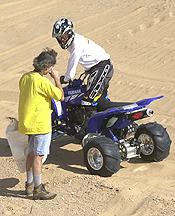 |
|
Off-road
journalist Bill "WBGO" Lanphier is really down on his luck and was
spotted at Glamis collecting aluminum cans in a burlap sack. |
Yamaha went big with the motor for the Raptor, but not the chassis. The overall dimensions are closer to a Honda 400EX than either the Bombardier DS650 or Suzuki's LT500R. In fact, the front stance is actually narrower than on a 400EX. The seat height, on the other hand, is in the DS650 range.
Yes, the Raptor is on the tall and narrow side. Combine that with soft front suspension settings and you have machine that dives a bit in turns. Experimentation with different tires and suspension settings has shown that this problem can be solved fairly easily. The stock rear radial tires, a first for Yamaha ATVs, hook up well for straight-ahead traction, but are a bit too grabby for smooth powerslides in dirt. The Kenda sand tires we tested in the dunes worked well, but the stock front suspension settings are still an issue. (Check out Dr. Dune's accompanying report on the Raptor's sand manners.)
The stock suspension does work well, however, for jumps, whoops and over rough terrain. The machine eats up big bumps easily and goes through whoops almost like a full-on desert racing quad. Even though the action is plush and the suspension travel numbers are exactly the same as on a Banshee, you'll have to jump the Raptor pretty damn high to get the suspension to bottom out. Lots of aluminum components (the upper A-arms, subframe, front spindles and hubs, for example) keep the weight down and the Raptor feels nimble in the air.
This nimble feeling is a big plus for woods riding, where a big quad like the DS650 feels more like an overloaded garbage truck. Despite the diving front end, the Raptor carves a precise turn and the steering is very responsive. The weight bias allows for instant wheelies. For riders who think the front end is too light, a longer swingarm is one solution that will also improve top-speed stability on the Raptor (which has a shorter wheelbase than the DS650, Banshee or LT500R).
COMFORTABLE?
If you were blindfolded, plopped down on the Raptor
and were told it was a Honda 400EX, you'd probably believe it. The
relative location of the bars, seat and footpegs is almost
identical. This is good news, because many riders feel right at
home on the EX. The largest riders might feel a bit cramped, but
will still be able to move around and ride hard. Despite the big
motor, the Raptor's hand controls work easily and smoothly. Thumb
throttle action is lighter than on the Banshee.
Routine maintenance on the Raptor isn't quite as easy as it is on most Hondas, but still easier than on the Banshee. A spin-on automotive-style filter is a welcome item. Overall fit and finish is excellent on the Raptor and we suspect the unit will hold up well in the long run.
IS IT YAMAHA OR IS IT
AFTERMARKET?
In the past, the big OEMs offered
only a few optional items (handguards, for example) for their
performance ATVs. Now, here's a switch. Yamaha is offering ten
different reasonably priced products for the Raptor including
skidplates, graphics kits-- even an exhaust system! We asked Yamaha
to slap some of these goodies on our Raptor and here's what they
came up with.
For the complete gallery of 31 full screen photos Click Here!
Click Here for page two of the
story!

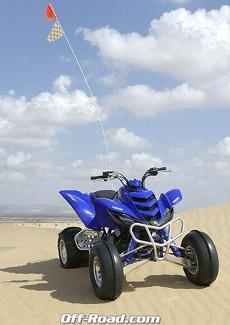

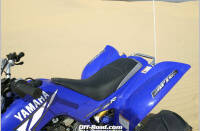
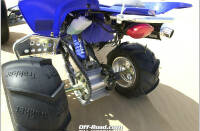
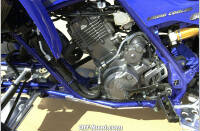
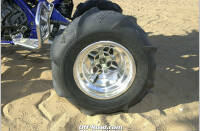
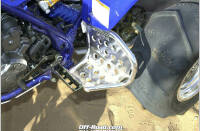
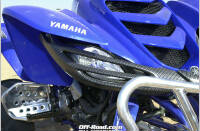
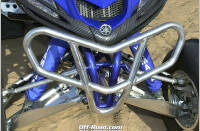

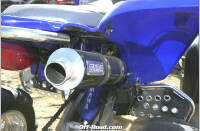
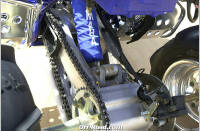
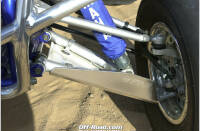
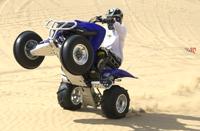
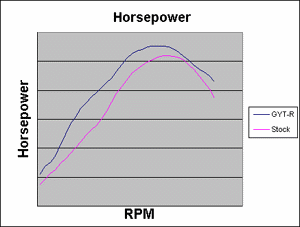
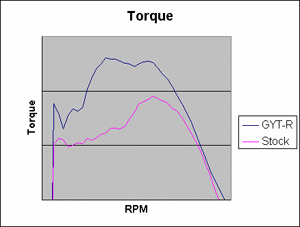

 Your Privacy Choices
Your Privacy Choices